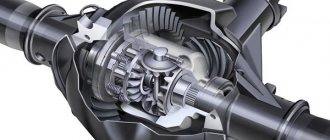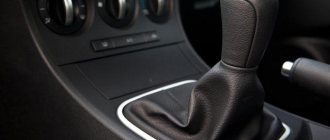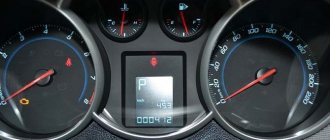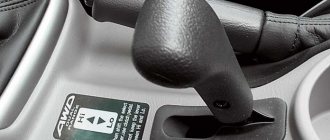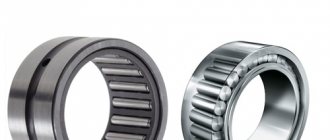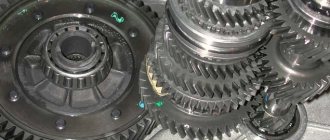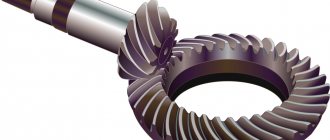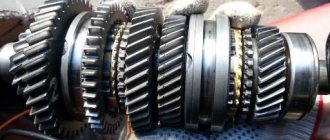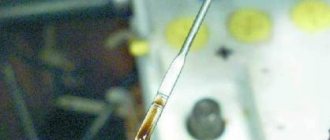Owners of cars with automatic transmission will be interested to know what overdrive is and how to use it.
Despite the fact that any gearbox that changes the gear ratio in accordance with the vehicle speed and engine speed without direct driver intervention can be called automatic (automatic transmission), this name is assigned only to the hydromechanical planetary gearbox. Although in the last few decades there have been cars with automatic gear shifting of manual transmissions with electromechanical or electro-pneumatic actuators, they are not called “automatic”. They came up with the name “robot”. The variator is not a gearbox at all, since it does not have a set of steps with a fixed gear ratio, but smoothly changes it as needed, therefore it is classified as a continuously variable transmission.
What is a synchronizer and what is it used for?
Synchronizer
- a design element of mechanical transmissions on shafts and gears of constant mesh, designed to synchronize the angular speeds of the locking clutch and gear when the gear is engaged.
Interesting materials:
What is the screen diagonal of iPhone 6 plus? What is the diagonal size of the iPhone 11 Pro Max? What is the diagonal size of iPhone 8 plus? What is the warranty for iPhones? What kind of camera does iPhone 8 plus have? What memory does the iPhone 11 Pro Max have? What's the difference between iPhone 11 and 11 pro? What's the difference between iPhone 7 and 7 plus? What SIM card is in iPhone 7 plus? What SIM is in iPhone 5S?
How to downshift gears on a manual transmission?
The simplest, but not the most effective way to smooth out the jerk when downshifting is to release the clutch pedal for a long time.
- Accelerate to 50 km/h in third gear
. ... - Release the gas pedal, simultaneously depress the clutch pedal and at the same time move the gear lever to neutral.
Interesting materials:
What is the bolt pattern on 2141? What is the bolt pattern on the BMW E39? What kind of bolt pattern on Daewoo Lanos? What is the bolt pattern for a Volkswagen Polo sedan? What is the bolt pattern for a Volkswagen Polo? What kind of bolt pattern on viburnum? What is the bolt pattern on a Hyundai Tucson? What is the bolt pattern on the Lada Priora? What is the bolt pattern on the Mitsubishi Outlander? What is the bolt pattern on the Mitsubishi Lancer 9?
Why do you need an upgrade step?
Overdrive is needed for more comfortable and economical travel over long distances. It should be enabled under the following conditions:
- Driving on the motorway.
- Continuous movement at constant speed.
- Traveling at high speeds.
Other operating modes of the machine
Using the selector handle you can select the following operating modes:
- P (parking) – Parking. In this mode, the intermediate shaft of the box is mechanically blocked, which leads to braking of the drive wheels. Starting the engine is usually possible only in this mode.
- R (rear) – Reverse.
- N (neutral) – Neutral. In this mode, the vehicle can be towed over short distances.
- D (drive) – Moving forward. Usually all stages of the transmission operate.
- 2 – range of low gears (1 and 2 or only 2) for driving on snow or mud.
- S (snow) - helps to move in modes with a reduced coefficient of adhesion to the road surface.
- L (low) or 1 – second low range (1 step only).
Gear ratio
The gear ratio is calculated as the ratio of the number of teeth on the driven gear to the number of teeth on the drive gear. It shows how many times the moment of force on the driven shaft is greater than on the driving shaft and is inversely proportional to the ratio of the angular velocities of the driven and driving shafts. In other words, a gear ratio below unity, which has overdrive, indicates that the moment of force on the secondary shaft of the box is less than on the primary shaft. And the rotation speed of the secondary shaft, on the contrary, is greater than the primary one.
Share with friends on social networks:
Telegram
Useful tips for beginners in SnowRunner
SnowRunner is reminiscent of the legendary Truckers series, only in a modern package. It will seem like this until the first task is completed. Later it becomes clear that the game has a lot more different mechanics and its own gameplay features.
To make it easier for newcomers to dive into the world of transportation, especially those who have never played something like this before, we have compiled a selection of useful SnowRunner tips that will help you better understand the game.
Winch is your best friend
You can use a winch on any vehicle. To fix it on the ground, just use a special menu. It is also possible to throw the winch to the point closest to the truck with the press of one button.
Once the winch is installed, you can either move towards it or activate a mode in which it will pull you out from anywhere. The second option is naturally more effective, and should be used in any unpleasant situation on the road. In SnowRunner, the winch is your faithful companion who will never leave you in trouble, don’t forget about it.
Look under the wheels
Surely you will start doing this on your own after a couple of races on the map, because you simply won’t be able to pull your truck out of the next hole. It's very easy to get stuck in any terrain in SnowRunner. It can be either a puddle that covers a huge hole, or a mud swamp, which from a distance seems like a completely normal road.
Moreover, a vehicle can get stuck out of the blue, even if not all wheels are submerged in water or mud. Over time, you yourself will learn to recognize such “traps” on the roads and begin to avoid them, but at the very beginning of the game you will probably have to get out of the pits several times.
Daily iron requirement in healthy people
Iron requirements vary depending on age and health status.
Infants under six months of age have little need for iron, since they are born with a fair supply of this element. Newborns only need 0.27 mg of iron per day. Children from six months to a year require 11 mg, children from 1-3 years old - 7 mg, children aged 4-8 years - 10 mg, 9-13 years old - 8 mg.
Adolescents 14–18 years old should receive 11–15 mg daily, with girls having a higher need for iron due to monthly blood loss during menstruation.
Men require about 10 mg of iron per day, women - 15-18 mg. During pregnancy, the norm increases to 25–35 mg, and during breastfeeding - to 25 mg.
After about 50 years, the iron requirement for men and women becomes the same - about 10 mg per day.
These are average figures, but in some cases the need for iron may be slightly higher than the statistical average. Athletes and people engaged in heavy physical labor require more iron. The need for iron also increases during recovery from operations and injuries (especially if they were accompanied by blood loss), infectious diseases, as well as for those who suffer from constant bleeding (hemorrhoids, stomach ulcers, nosebleeds, heavy menstruation, etc.).
Dependence of transmission on drive
Design features vary for different types of transmissions. In total there are the following drive types:
- Front wheel drive.
- Rear wheel drive.
- All-wheel drive.
There is such a thing as a car wheel formula, which includes 2 digits. Explanation: the first is the total number of wheels, and the second is the number of drive wheels. So front- and rear-wheel drive are designated 4×2, and all-wheel drive – 4×4.
Device
The manual transmission is part of the car's transmission and works in tandem with the clutch, which may not be present in other types of transmissions (automatic). In the past, high-end passenger cars used a fluid coupling instead of a clutch, but these days this type of semi-automatic transmission is not used due to the high engine power loss and low efficiency of the fluid coupling. At the moment, manual gearboxes without a clutch are used only in metalworking machines. The clutch is necessary to equalize the rotation speed of pairs of gears. Without using the clutch, manual transmission gear shifting is impossible. The clutch is also used to smoothly start the vehicle and briefly disconnect the engine from the transmission mechanisms when stopping. The main components of the manual transmission are: a crankcase, a set of parallel rotating shafts, gears mounted on the shafts, a synchronizer. At the moment, two types of manual transmissions are most widespread - three-shaft (most rear-wheel drive cars with a classic layout and, in part, front-wheel drive cars) and two-shaft (a significant part of front-wheel drive cars). The three-shaft box contains three shafts - primary, intermediate and secondary. The front shaft is connected through the clutch to the crankshaft (flywheel) of the engine. Secondary - with a driveshaft that transmits torque to the main gear, or with the main gear itself (in rear-wheel drive cars and in cars with a spaced transmission). The intermediate shaft serves to transmit torque through gears from the primary to the secondary shaft. The primary and secondary shafts are installed in M coaxially - the front part of the secondary shaft fits into a groove in the rear of the primary shaft and rotates in it on a bearing. Mechanically, the input and output shafts are connected only by the countershaft gears and rotate independently of each other. One drive gear is rigidly fixed to the input shaft, which meshes with the intermediate shaft gear. A freely rotating gear block is located on the secondary shaft. Each of the secondary shaft gears is located on a strictly defined section of the shaft; its longitudinal (along the shaft) movement is excluded. At the same time, the gear shift mechanism locks the selected gear on the secondary shaft, transmitting torque from the input shaft through the intermediate gear - this is how the gear is engaged. A set of gears are rigidly fixed to the intermediate shaft and are always in constant mesh. The input shaft gear transmits rotation to the first (driven) gear of the intermediate shaft. Together with the intermediate shaft, its gears also rotate, transmitting rotation to pairs of matched, constantly meshed gears of the secondary shaft. Thus, when the clutch is engaged and the engine is running, all gears of the primary, intermediate and secondary shafts are in rotation, regardless of the selected gear. To reduce wear and compensate for the forces acting on the gear teeth, all gears of modern manual transmissions are helical.
Experiment 13
Problem 1
Build underdrive and overdrive gears with ratios of 1:5 and 3:1.
Problem 2
Assemble the gear train on both sides of the beam. Try changing the mechanism using other gears.
Problem 3
Build a capture model. Place the worm between the gears
Problem 4
Build a helicopter model using gears in different planes.
Extending the life of automation
First of all, the performance potential of the automatic transmission is determined by careful operation. An important factor that prolongs the durability of the mechanism is timely and high-quality maintenance.
The duration of a comfortable ride on an automatic transmission will be longer if you constantly monitor the oil level in the box. Using a dipstick from the engine will help sort this out. The main thing is to prevent leaks by changing the oil and filter. It is advisable to do this every 40–60 thousand km. Also, do not save money; it is better to use the original product.
In terms of operation, automation is many times more complex than mechanics. Moreover, such a transmission is more suitable for traveling around a metropolis. There’s just a nuance: the machine doesn’t like high overloads. Do not torture the system until it warms up. This is especially true in winter.
Once you change from a manual to an automatic, you can confidently say: you won’t change back.
Iron and iron health: what role does the microelement play in our body?
Iron is part of hemoglobin. In turn, the protein hemoglobin is a building material for erythrocytes - red blood cells that carry oxygen from the lungs to the organs, and on the way back rid them of carbon dioxide. Actually, this process is called cellular respiration. Without iron it is impossible. And since every cell in our body needs oxygen, iron can be called one of the most important elements.
The synthesis of hemoglobin takes 60–70% of all iron entering the body. The remaining 30–40% is deposited in tissues and spent on solving other problems - metabolic processes, regulation of the thyroid gland, maintaining the body's defense system and connective tissue synthesis.
As you can see, the functions of iron are varied and numerous, but oxygen transport is the most important of them.
Iron is poorly absorbed even with ideal health and proper diet - the human body is able to absorb up to 10% of the iron supplied with food.
When to turn off overdrive
It is recommended to disable this automatic transmission mode:
- Overtaking at high speed if this requires a lot of acceleration. In such a situation, it will be more effective to use the kick down mode.
- Driving off-road.
- Towing a heavy vehicle or trailer.
- Driving downhill when you need to slow down the engine.
- On a long climb.
- Moving at a speed of no more than 60 km/h.
- If the road situation requires a constant change in speed.
Overdrive in the city
Do I need to turn off overdrive in the city? There are two diametrically opposed opinions on this matter, which we will now present together with the arguments of both sides.
The first opinion is that in the city this mode must be turned off. This is explained by the fact that in the city, unlike on the highway, it is impossible to move for a long time at a constant speed, so the box will not be able to work in overdrive most of the time. This happens due to the large number of other traffic participants and traffic lights. And since the car cannot move for a long time in overdrive, its automatic transmission makes a large number of gear changes and torque converter locks. Therefore, firstly, fuel consumption increases, and secondly, wear of automatic transmission parts and components increases.
The second opinion, as you might guess, is that the mode that increases the automatic transmission ratio does not need to be turned off. The argument of drivers using overdrive mode in the city is as follows. In the city cycle, the automatic transmission makes more shifts than on the highway, regardless of whether overdrive is on or not. The situation is similar with fuel consumption, which, with the same driving style at the same time of year, in the city is higher than on the highway. Therefore, driving in overdrive will at least slightly reduce fuel consumption.
Article on the topic: How the Start-Stop system works
Operation of the box with stage IV turned on
If overdrive is not turned off, then when accelerating the car, the gearbox sequentially switches gears from I to IV.
During operation of the boost stage, the torque converter lockup is activated. At this moment, you can feel a slight push, which some car enthusiasts associate with upshifting.
Although this push is not a consequence of going into overdrive, its presence indirectly confirms that the box is switching to an upshift. During braking, the torque converter unlocks and shifts to lower gears.
Gear housings
Standardized cast gearbox housings are widely used in mass production. Most often, in heavy industry and mechanical engineering, housings are made of cast iron, less often of cast steel. When it is necessary to make the design as light as possible, light alloy bodies are used. The gearbox housing most often has attachment points - paws and/or ears, by which the gearboxes are moved and/or secured to the base. At the output of the shafts, seals are placed to prevent oil leakage. Structural elements are often placed on the gearbox housings to prevent an increase in pressure inside the gearbox resulting from the heating of the gearbox during operation.
Turn on the "lower"
By starting a low-range gear, a large torque is transmitted to the wheel drive. As a result, difficult roads can be overcome without serious load on the engine.
This mode is not the only one on modern machines. The driver can also select other operating modes. You can save fuel while traveling on highways by switching the gearbox to high-speed operation. We often encounter the problem of traffic jams; in such a situation, it is logical to switch the gearbox to a mode not exceeding first gear. Typically this setting is used when driving at low speeds.
